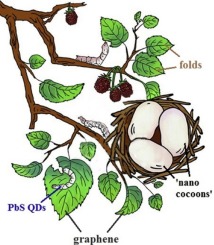Sensors and Actuators B: Chemical ( IF 8.0 ) Pub Date : 2017-09-20 , DOI: 10.1016/j.snb.2017.09.120 Yueli Liu , Haoran Wang , Shuang Yang , Keqiang Chen , Tingqiang Yang , Jin Wei , Jingwen Tian , Wen Chen

|
The development of novel sensing materials is the key issue for the effective detection of ammonia gas at room temperature. In the present work, the novel 3-D cocoon-like architectures of PbS quantum dots (QDs)/reduced graphene oxide (rGO) composites are self-assembled by using one-step liquid phase method, and the formation process may be vividly depicted by the natural formation process of the ‘silk cocoons’. 3-D PbS QDs/rGO nanococoons show a good detection limit of 750 ppb towards ammonia gas at room temperature, which is significantly enhanced compared with those of pure PbS QDs and rGO. Meanwhile, the gas sensing response will be greatly decreased with the increasing of the working temperature and there is no response at 150 °C, resulting from Schottky barrier modulation. The abnormal dependence of the gas response on the working temperature may be a unique fingerprint calibration for the ammonia detection. In addition, 3-D PbS QDs/rGO nanococoons have a relatively good selectivity towards ammonia gas at room temperature compared with ethanol, acetone and so on, and the long term test proves that they possess an excellent sensing stability. The sensing enhancement at room temperature may be due to the 3-D special architecture and well-combined interfaces of 3-D PbS QDs/rGO nanococoons, which may favor for the absorption of the gas molecules and the fast charge transport from PbS QDs to rGO, respectively.
中文翻译:

在室温下检测3-D PbS量子点/还原的氧化石墨烯纳米茧的ppb级氨和肖特基势垒调制行为
新型传感材料的开发是在室温下有效检测氨气的关键问题。在目前的工作中,新颖的3-D茧状结构的PbS量子点(QDs)/还原氧化石墨烯(rGO)复合材料是通过一步液相方法自组装的,可以形象地描绘其形成过程。通过“丝绸茧”的自然形成过程。3-D PbS QDs / rGO纳米茧在室温下对氨气的检测限为750 ppb,与纯PbS QDs和rGO相比,显着提高。同时,随着工作温度的升高,气体感应响应将大大降低,并且在150°C时由于肖特基势垒调制而没有响应。气体响应对工作温度的异常依赖性可能是氨气检测的唯一指纹校准。另外,与乙醇,丙酮等相比,3-D PbS QDs / rGO纳米茧在室温下对氨气具有相对较好的选择性,长期测试证明它们具有出色的感测稳定性。室温下的感测增强可能归因于3-D PbS QDs / rGO纳米茧的3-D特殊结构和良好结合的界面,这可能有利于气体分子的吸收和从PbS QD到Cb的快速电荷传输。 rGO,分别。丙酮等,长期测试证明它们具有出色的传感稳定性。室温下的感测增强可能归因于3-D PbS QDs / rGO纳米茧的3-D特殊结构和良好结合的界面,这可能有利于气体分子的吸收和从PbS QD到Cb的快速电荷传输。 rGO,分别。丙酮等,长期测试证明它们具有出色的传感稳定性。室温下的感测增强可能归因于3-D PbS QDs / rGO纳米茧的3-D特殊结构和良好结合的界面,这可能有利于气体分子的吸收和从PbS QD到Cb的快速电荷传输。 rGO,分别。











































 京公网安备 11010802027423号
京公网安备 11010802027423号